ScreenAnarchy in Bondage: Am I Not Your Bond Girl
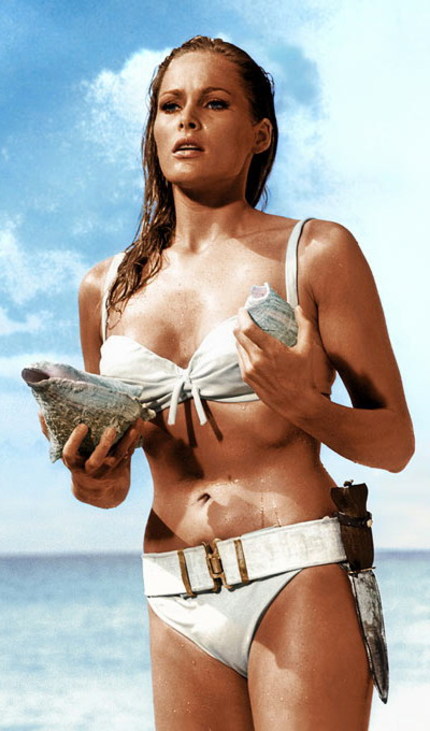
Let's get this out of the way: none of the characters in the Bond film series are what you would call psychologically nuanced. While this arguably has changed in the Craig years, there is little background information or screen time for any of the characters (except Bond) to establish a well-rounded presence. This has been especially true of the Bond Girl, who has been criticized (especially in the early years) as spectacularized and eroticized to the point of caricature. With character names such as Honey Rider, Pussy Galore, Plenty O' Toole and Xenia Ontatopp, there was little doubt for viewers as to the 'role' these characters had in Bond's story. According to academic Janet Woollacott, in Ian Fleming's novels (which I have not read), the women are assertive, sexy, sometimes wicked, and have a claim to independence, and they are not romantic or clingy. Not all of these traits transferred to the films, which were (at least in the early years) products of their times and attitudes towards women. Luckily, times have changed, and the female companions and foils along with them. But let's take a look at the evolution of the Bond Girl through the past 50 years.
THE EARLY YEARS
Ursula Andress set the bar pretty high when she emerged from the sea in a white bikini and packing a knife in Dr. No (1962). And while she, like all Bond Girls, is beautiful and resourceful, sexually active and independent, she is also damaged, and reliant upon men. This was the 1960s, still the cold war era, and a woman with power was still seen as out of place. At this time, women still had to be put down in some fashion. From Russia with Love featured both bad and good Bond Girls, but this was still the damaged woman, meant to be rescued by Bond. A woman who asserts herself, such as in Goldfinger and Thunderball, was killed.
Goldfinger is an exception - well, sort of. Fresh off her successful run on the television series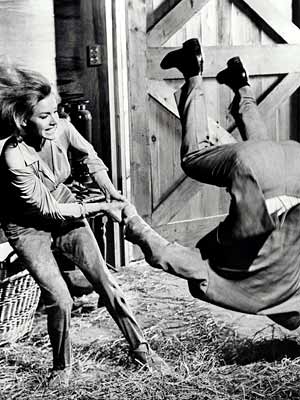 The Avengers, Honor Blackman played the aptly named Pussy Galore, who runs her own circus (a strange idea that will reoccur in Octopussy) and is pilot and henchman to the title villain. In the novel, she is openly presented (thought not necessarily favourably) as a lesbian. In the film, this is only hinted at (though perhaps most strongly through her name, a wonderful double entrendre if ever there was one). So Pussy had as much, or perhaps more, sexual liberation than the women of that era (and they were certainly believed to have a lot that free love time), but she still had to be held back. A woman immune to Bond's charms is, naturally, unacceptable, and so she is seduced by him and joins his side. Again, a woman with power is put in her place. And in her place, she is saved.
The Avengers, Honor Blackman played the aptly named Pussy Galore, who runs her own circus (a strange idea that will reoccur in Octopussy) and is pilot and henchman to the title villain. In the novel, she is openly presented (thought not necessarily favourably) as a lesbian. In the film, this is only hinted at (though perhaps most strongly through her name, a wonderful double entrendre if ever there was one). So Pussy had as much, or perhaps more, sexual liberation than the women of that era (and they were certainly believed to have a lot that free love time), but she still had to be held back. A woman immune to Bond's charms is, naturally, unacceptable, and so she is seduced by him and joins his side. Again, a woman with power is put in her place. And in her place, she is saved.
The later Connery films weren't much better for the girls. It took the sole George Lazenby film, On Her Majesty's Secret Service, to bring in the first solid, smart, strong, and independent Bond Girl. Oddly enough, this was another veteran of The Avengers, Diana Rigg. Rigg's Tracy at first seems to fall into the typical Bond Girl characteristics: she is independent, sexual available, vulnerable, and needs to be rescued by Bond. However, Tracy can more than hold her own, and Bond, rather than loving-and-leaving, marries her. But of course she is killed at the end of the film, leaving Bond free to pursue his sexual exploits.
So the early years were, overall, not too kind to the Bond Girls, who may have had some empowering qualities, but were limited in part by the source material, and even more so by the constraints on roles for women in that era.
THE MIDDLE YEARS
The first two Roger Moore films did not suggest much of a change for the role of the Bond Girl. Although The Man with the Golden Gun featured a female agent who displayed skill at her job, she was mostly relegated to pouting over being left in a closet while Bond had sex with another woman, and still needed to be rescued by him at the end of the film.
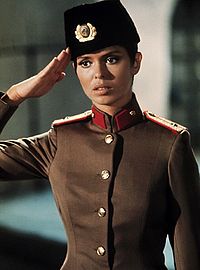 But things went up several notches in The Spy Who Loved Me. The film introduced another female spy in Russian agent Anya Amasova (Barbara Bach). She was just as good at her job as Bond, as independent and sexually available as previous Bond Girls, but unlike them, she did not spend the film pining for Bond, nor have sex with him until the end. This was the first of the Bond films to have a great narrative interest in the relationship between Bond and his girl, and Anya remains an independent character with as much of a well-rounded character as one can expect in this film series.
But things went up several notches in The Spy Who Loved Me. The film introduced another female spy in Russian agent Anya Amasova (Barbara Bach). She was just as good at her job as Bond, as independent and sexually available as previous Bond Girls, but unlike them, she did not spend the film pining for Bond, nor have sex with him until the end. This was the first of the Bond films to have a great narrative interest in the relationship between Bond and his girl, and Anya remains an independent character with as much of a well-rounded character as one can expect in this film series.
The trend of smart, truly independent, and perhaps sexual available but somewhat discriminating women continued for the next two films. Moonraker featured Holly Goodhead (Lois Chiles), an astronaut (fictionally beating out the first American woman in space by four years), who might not have the spy skills, but nonetheless proves effective as a sidekick, and again, does not give into sexual temptation with Bond until the end of the film. As I wrote at the beginning, For Your Eyes Only features the kick-ass Melina, who joins with Bond out of opportunity in order to continue to exact her revenge on the murder of her parents, and like Goodhead, makes a choice of sleeping with Bond at the end of the film. Octopussy was a bit of a slide back; while the title character (Maud Adams, who played another Bond girl in The Man with the Golden Gun) does sleep with Bond in the middle of the film, she is still an independent woman who makes her own choice to betray the villain.
The Moore years of Bond Girls capped off greatly in A View to a Kill with the henchmen May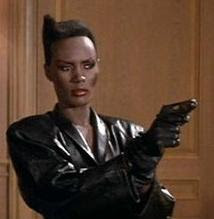 Day. Given the weakness of the good Bond Girl, May Day was badass in the most delicious way. She has sex with Bond in order to keep him occupied and get more information; in other words, turning the tables on him. While the Bond films have always been a little better about interracial relationships (this was not the first black female character that Bond slept with) they are still rare. As the evil henchman, she must die in the end, but she must be blown up to die, and she does so in revenge against the villain Zorin, on her own terms, accepting her death as the price to stop him.
Day. Given the weakness of the good Bond Girl, May Day was badass in the most delicious way. She has sex with Bond in order to keep him occupied and get more information; in other words, turning the tables on him. While the Bond films have always been a little better about interracial relationships (this was not the first black female character that Bond slept with) they are still rare. As the evil henchman, she must die in the end, but she must be blown up to die, and she does so in revenge against the villain Zorin, on her own terms, accepting her death as the price to stop him.
While the Timothy Dalton years have overall received undeserved criticism, they did little for the progression of the Bond Girl. But the middle years pushed her forward into greater equality and greater richness of character.
THE LATER YEARS
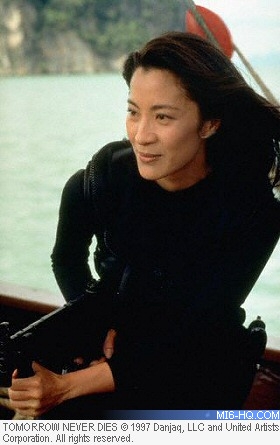 The Brosnan years were a mixed bag of Bond Girls. I doubt anyone who has seen Goldeneye will forget the sight of henchman Xenia Onatopp (Famke Janssen) squeezing a man to death with her thighs during sex. Perhaps that is the ultimate display of female power, turning the tables on a man who would see her only as an object. Tomorrow Never Dies featured two Bond Girls: Paris (Teri Hatcher), a former flame of Bond's, whose death Bond seems to mourn with true feeling. And the second female spy, Wai Lin (Michelle Yeoh.) Yeoh's reputation as not only a great actress but one with action skills preceded her, and she filled the bill as a spy equal to Bond, and although sex between her and Bond is suggested, it isn't shown. This might be a first for the Bond series, and made a welcome change, concentrating on the story and action.
The Brosnan years were a mixed bag of Bond Girls. I doubt anyone who has seen Goldeneye will forget the sight of henchman Xenia Onatopp (Famke Janssen) squeezing a man to death with her thighs during sex. Perhaps that is the ultimate display of female power, turning the tables on a man who would see her only as an object. Tomorrow Never Dies featured two Bond Girls: Paris (Teri Hatcher), a former flame of Bond's, whose death Bond seems to mourn with true feeling. And the second female spy, Wai Lin (Michelle Yeoh.) Yeoh's reputation as not only a great actress but one with action skills preceded her, and she filled the bill as a spy equal to Bond, and although sex between her and Bond is suggested, it isn't shown. This might be a first for the Bond series, and made a welcome change, concentrating on the story and action.
The World is Not Enough featured the first high-ranking female villain in Elektra (Sophie Marceau), also a refreshing change; Elektra is independent, intelligent and sexually available, though not so much to Bond. Unfortunately, this new Bond Girl was rendered almost obsolete by the horrible Christmas Jones (Denise Richards). According to an interview with BBC News, Richards claimed she liked the role because (in her words), unlike previous Bond Girls, Jones was brainy, athletic, and had depth. This pretty much proved that Richards had never bothered to watch more than a select few of the previous films, and the character, despite claiming to be a nuclear physicist, felt like a throwback to the sexist days. At least Die Another Day attempted to make up for it with two strong Bond Girls in Jinx (Halle Berry) and Miranda Frost (Rosamund Pike), both of whom have sex with Bond of their own accord, and in Frost's case, as much to use him as he uses her. Admittedly, the final fight between Jinx and Frost borders on fetishism/lesbian voyeurism, but it's still a good scene.
While the first of the Daniel Craig films, Casino Royale, did not offer any female spies, it was not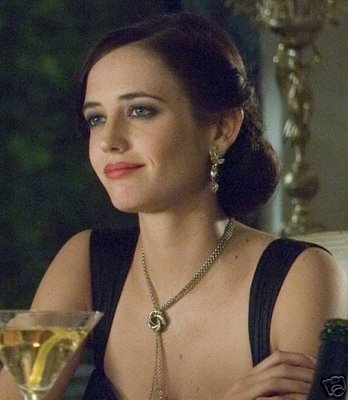 without strong Bond Girls. Solange (Caterina Murino), as wife of one of the villains, must by default be an object of desire, but she is far from just a pretty face, and while she dies in the rather typical manner of women who betray the bad guys, she is not presented in a dismissive manner. Vesper Lynd (Eva Green) is, in her words, 'the money,' and she has no spy or fighting skills; indeed, she represents the ordinary person (the audience by extension) caught up in violence of which she has no understanding and is therefore somewhat traumatized. She does allow herself to die for betraying Bond, but she is not weak, nor is her character two-dimensional. Quantum of Solace offers both the lesser and the better of the Bond Girl types. Strawberry Fields (Gemma Arterton) is a return to the double-entendre name; she's said to be an office worker out of her depth, but who, like Bond, uses her skill, strength, and sexual prowess to get the information. Unfortunately, she falls for Bond's charms perhaps a bit too easily, and is killed when she steps out of her power circle. Camille (Olga Kurylenko) is akin to Melina in her desire for revenge; like Yeoh, she did her own action stunts, and like Yeoh, she is never seen in bed with Bond.
without strong Bond Girls. Solange (Caterina Murino), as wife of one of the villains, must by default be an object of desire, but she is far from just a pretty face, and while she dies in the rather typical manner of women who betray the bad guys, she is not presented in a dismissive manner. Vesper Lynd (Eva Green) is, in her words, 'the money,' and she has no spy or fighting skills; indeed, she represents the ordinary person (the audience by extension) caught up in violence of which she has no understanding and is therefore somewhat traumatized. She does allow herself to die for betraying Bond, but she is not weak, nor is her character two-dimensional. Quantum of Solace offers both the lesser and the better of the Bond Girl types. Strawberry Fields (Gemma Arterton) is a return to the double-entendre name; she's said to be an office worker out of her depth, but who, like Bond, uses her skill, strength, and sexual prowess to get the information. Unfortunately, she falls for Bond's charms perhaps a bit too easily, and is killed when she steps out of her power circle. Camille (Olga Kurylenko) is akin to Melina in her desire for revenge; like Yeoh, she did her own action stunts, and like Yeoh, she is never seen in bed with Bond.
In fact, since the Brosnan years, there has been less sex in the Bond films. While I appreciate that this is a big part of the original concept, its lack doesn't seem to have hurt the series. There are still beautiful women, but the films are at least making them good characters as opposed to merely objects, though the beauty is still a must. This trend looks to be continuing in Skyfall. The series must have its Bond Girls, but as the film series has moved beyond the early sexism of the novels and the first films, so too can she evolve.
Postscript: Best Honourary Bond Girl
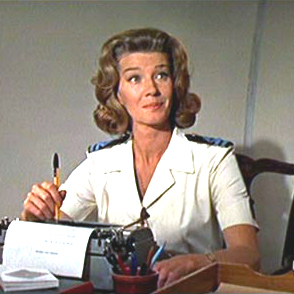 This title must go, without a doubt, to Miss Moneypenny. Played through the Connery and Moore years by Canadian actress Lois Maxwell (and subsequently by Caroline Bliss and Samantha Bond,) Moneypenny never slept with Bond, but their flirtation was always a highlight of the films. She is the perfect foil to Bond; while neither character explicitly asks for any romantic entanglement, I always thought that if Bond asked, Moneypenny would turn him down. Maxwell once famously said that she would have had Moore as a husband, and Connery as a weekend lover. Although she rarely appeared in more than one scene, she was and is a memorable character, and perhaps would be Bond's best match.
This title must go, without a doubt, to Miss Moneypenny. Played through the Connery and Moore years by Canadian actress Lois Maxwell (and subsequently by Caroline Bliss and Samantha Bond,) Moneypenny never slept with Bond, but their flirtation was always a highlight of the films. She is the perfect foil to Bond; while neither character explicitly asks for any romantic entanglement, I always thought that if Bond asked, Moneypenny would turn him down. Maxwell once famously said that she would have had Moore as a husband, and Connery as a weekend lover. Although she rarely appeared in more than one scene, she was and is a memorable character, and perhaps would be Bond's best match.
Obviously, I've just scratched the surface of Bond Girls and their legacy. So please add your thoughts: favourites and least favourites, forgotten or forgettable.
Ursula Andress set the bar pretty high when she emerged from the sea in a white bikini and packing a knife in Dr. No (1962). And while she, like all Bond Girls, is beautiful and resourceful, sexually active and independent, she is also damaged, and reliant upon men. This was the 1960s, still the cold war era, and a woman with power was still seen as out of place. At this time, women still had to be put down in some fashion. From Russia with Love featured both bad and good Bond Girls, but this was still the damaged woman, meant to be rescued by Bond. A woman who asserts herself, such as in Goldfinger and Thunderball, was killed.
Goldfinger is an exception - well, sort of. Fresh off her successful run on the television series
 The Avengers, Honor Blackman played the aptly named Pussy Galore, who runs her own circus (a strange idea that will reoccur in Octopussy) and is pilot and henchman to the title villain. In the novel, she is openly presented (thought not necessarily favourably) as a lesbian. In the film, this is only hinted at (though perhaps most strongly through her name, a wonderful double entrendre if ever there was one). So Pussy had as much, or perhaps more, sexual liberation than the women of that era (and they were certainly believed to have a lot that free love time), but she still had to be held back. A woman immune to Bond's charms is, naturally, unacceptable, and so she is seduced by him and joins his side. Again, a woman with power is put in her place. And in her place, she is saved.
The Avengers, Honor Blackman played the aptly named Pussy Galore, who runs her own circus (a strange idea that will reoccur in Octopussy) and is pilot and henchman to the title villain. In the novel, she is openly presented (thought not necessarily favourably) as a lesbian. In the film, this is only hinted at (though perhaps most strongly through her name, a wonderful double entrendre if ever there was one). So Pussy had as much, or perhaps more, sexual liberation than the women of that era (and they were certainly believed to have a lot that free love time), but she still had to be held back. A woman immune to Bond's charms is, naturally, unacceptable, and so she is seduced by him and joins his side. Again, a woman with power is put in her place. And in her place, she is saved.The later Connery films weren't much better for the girls. It took the sole George Lazenby film, On Her Majesty's Secret Service, to bring in the first solid, smart, strong, and independent Bond Girl. Oddly enough, this was another veteran of The Avengers, Diana Rigg. Rigg's Tracy at first seems to fall into the typical Bond Girl characteristics: she is independent, sexual available, vulnerable, and needs to be rescued by Bond. However, Tracy can more than hold her own, and Bond, rather than loving-and-leaving, marries her. But of course she is killed at the end of the film, leaving Bond free to pursue his sexual exploits.
So the early years were, overall, not too kind to the Bond Girls, who may have had some empowering qualities, but were limited in part by the source material, and even more so by the constraints on roles for women in that era.
THE MIDDLE YEARS
The first two Roger Moore films did not suggest much of a change for the role of the Bond Girl. Although The Man with the Golden Gun featured a female agent who displayed skill at her job, she was mostly relegated to pouting over being left in a closet while Bond had sex with another woman, and still needed to be rescued by him at the end of the film.
 But things went up several notches in The Spy Who Loved Me. The film introduced another female spy in Russian agent Anya Amasova (Barbara Bach). She was just as good at her job as Bond, as independent and sexually available as previous Bond Girls, but unlike them, she did not spend the film pining for Bond, nor have sex with him until the end. This was the first of the Bond films to have a great narrative interest in the relationship between Bond and his girl, and Anya remains an independent character with as much of a well-rounded character as one can expect in this film series.
But things went up several notches in The Spy Who Loved Me. The film introduced another female spy in Russian agent Anya Amasova (Barbara Bach). She was just as good at her job as Bond, as independent and sexually available as previous Bond Girls, but unlike them, she did not spend the film pining for Bond, nor have sex with him until the end. This was the first of the Bond films to have a great narrative interest in the relationship between Bond and his girl, and Anya remains an independent character with as much of a well-rounded character as one can expect in this film series. The trend of smart, truly independent, and perhaps sexual available but somewhat discriminating women continued for the next two films. Moonraker featured Holly Goodhead (Lois Chiles), an astronaut (fictionally beating out the first American woman in space by four years), who might not have the spy skills, but nonetheless proves effective as a sidekick, and again, does not give into sexual temptation with Bond until the end of the film. As I wrote at the beginning, For Your Eyes Only features the kick-ass Melina, who joins with Bond out of opportunity in order to continue to exact her revenge on the murder of her parents, and like Goodhead, makes a choice of sleeping with Bond at the end of the film. Octopussy was a bit of a slide back; while the title character (Maud Adams, who played another Bond girl in The Man with the Golden Gun) does sleep with Bond in the middle of the film, she is still an independent woman who makes her own choice to betray the villain.
The Moore years of Bond Girls capped off greatly in A View to a Kill with the henchmen May
While the Timothy Dalton years have overall received undeserved criticism, they did little for the progression of the Bond Girl. But the middle years pushed her forward into greater equality and greater richness of character.
THE LATER YEARS
 The Brosnan years were a mixed bag of Bond Girls. I doubt anyone who has seen Goldeneye will forget the sight of henchman Xenia Onatopp (Famke Janssen) squeezing a man to death with her thighs during sex. Perhaps that is the ultimate display of female power, turning the tables on a man who would see her only as an object. Tomorrow Never Dies featured two Bond Girls: Paris (Teri Hatcher), a former flame of Bond's, whose death Bond seems to mourn with true feeling. And the second female spy, Wai Lin (Michelle Yeoh.) Yeoh's reputation as not only a great actress but one with action skills preceded her, and she filled the bill as a spy equal to Bond, and although sex between her and Bond is suggested, it isn't shown. This might be a first for the Bond series, and made a welcome change, concentrating on the story and action.
The Brosnan years were a mixed bag of Bond Girls. I doubt anyone who has seen Goldeneye will forget the sight of henchman Xenia Onatopp (Famke Janssen) squeezing a man to death with her thighs during sex. Perhaps that is the ultimate display of female power, turning the tables on a man who would see her only as an object. Tomorrow Never Dies featured two Bond Girls: Paris (Teri Hatcher), a former flame of Bond's, whose death Bond seems to mourn with true feeling. And the second female spy, Wai Lin (Michelle Yeoh.) Yeoh's reputation as not only a great actress but one with action skills preceded her, and she filled the bill as a spy equal to Bond, and although sex between her and Bond is suggested, it isn't shown. This might be a first for the Bond series, and made a welcome change, concentrating on the story and action.The World is Not Enough featured the first high-ranking female villain in Elektra (Sophie Marceau), also a refreshing change; Elektra is independent, intelligent and sexually available, though not so much to Bond. Unfortunately, this new Bond Girl was rendered almost obsolete by the horrible Christmas Jones (Denise Richards). According to an interview with BBC News, Richards claimed she liked the role because (in her words), unlike previous Bond Girls, Jones was brainy, athletic, and had depth. This pretty much proved that Richards had never bothered to watch more than a select few of the previous films, and the character, despite claiming to be a nuclear physicist, felt like a throwback to the sexist days. At least Die Another Day attempted to make up for it with two strong Bond Girls in Jinx (Halle Berry) and Miranda Frost (Rosamund Pike), both of whom have sex with Bond of their own accord, and in Frost's case, as much to use him as he uses her. Admittedly, the final fight between Jinx and Frost borders on fetishism/lesbian voyeurism, but it's still a good scene.
While the first of the Daniel Craig films, Casino Royale, did not offer any female spies, it was not
In fact, since the Brosnan years, there has been less sex in the Bond films. While I appreciate that this is a big part of the original concept, its lack doesn't seem to have hurt the series. There are still beautiful women, but the films are at least making them good characters as opposed to merely objects, though the beauty is still a must. This trend looks to be continuing in Skyfall. The series must have its Bond Girls, but as the film series has moved beyond the early sexism of the novels and the first films, so too can she evolve.
Postscript: Best Honourary Bond Girl
 This title must go, without a doubt, to Miss Moneypenny. Played through the Connery and Moore years by Canadian actress Lois Maxwell (and subsequently by Caroline Bliss and Samantha Bond,) Moneypenny never slept with Bond, but their flirtation was always a highlight of the films. She is the perfect foil to Bond; while neither character explicitly asks for any romantic entanglement, I always thought that if Bond asked, Moneypenny would turn him down. Maxwell once famously said that she would have had Moore as a husband, and Connery as a weekend lover. Although she rarely appeared in more than one scene, she was and is a memorable character, and perhaps would be Bond's best match.
This title must go, without a doubt, to Miss Moneypenny. Played through the Connery and Moore years by Canadian actress Lois Maxwell (and subsequently by Caroline Bliss and Samantha Bond,) Moneypenny never slept with Bond, but their flirtation was always a highlight of the films. She is the perfect foil to Bond; while neither character explicitly asks for any romantic entanglement, I always thought that if Bond asked, Moneypenny would turn him down. Maxwell once famously said that she would have had Moore as a husband, and Connery as a weekend lover. Although she rarely appeared in more than one scene, she was and is a memorable character, and perhaps would be Bond's best match.Obviously, I've just scratched the surface of Bond Girls and their legacy. So please add your thoughts: favourites and least favourites, forgotten or forgettable.

Do you feel this content is inappropriate or infringes upon your rights? Click here to report it, or see our DMCA policy.





 (1)-thumb-80x80-93563.jpg)
